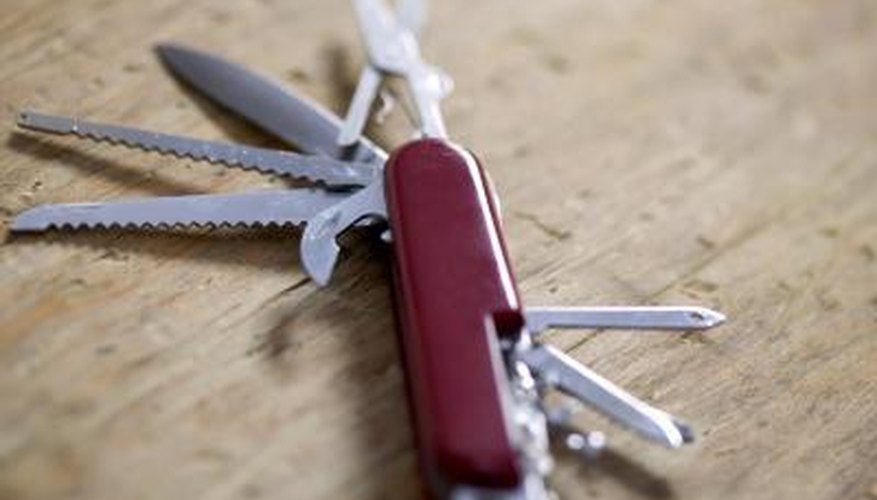Originating in Switzerland in the late 19th century, the Swiss Army Knife is a multi-function pocketknife and multi-tool that incorporates mechanisms as diverse as screwdrivers and toothpicks to can openers. The knife’s blade, typically the largest portion of the pocketknife, is tightly stowed inside the Swiss Army Knife’s handle along with other tools and is accessed using a pivot point mechanism. With a careful eye for detail and some basic supplies, practically anyone can replace the blade of a Swiss Army Knife.
Designate a working area with ample light for disassembling and reassembling your pocketknife. Ensure that the area is clear of any dirt, dust or other debris.
Locate the scales present on the knife’s outer surface and insert the thin utility knife beneath the scale to pry it loose. Apply pressure carefully as the attaching pin of each scale is released (most models come with four scales), and place the scales in a secure position nearby.
- Originating in Switzerland in the late 19th century, the Swiss Army Knife is a multi-function pocketknife and multi-tool that incorporates mechanisms as diverse as screwdrivers and toothpicks to can openers.
- Apply pressure carefully as the attaching pin of each scale is released (most models come with four scales), and place the scales in a secure position nearby.
Examine the Swiss Army Knife and locate the remaining rivet connecting the two outer portions of the pocketknife. Insert the thin finish nail into the exposed end of the rivet (located in a small housing or metal “bush”), and gently tap the back of the nail with the hammer until the rivet is driven through to the end of the knife.
Remove any extra pins from the knife in this manner while maintaining a grip on the pocketknife to ensure that the inner contents do not fall out.
- Examine the Swiss Army Knife and locate the remaining rivet connecting the two outer portions of the pocketknife.
- Remove any extra pins from the knife in this manner while maintaining a grip on the pocketknife to ensure that the inner contents do not fall out.
Place the intact Swiss Army Knife on the work surface and carefully lift the outer unit facing up. Take note of the placement of each tool as you remove them on the way to your knife blade. Remove the old blade and replace it with the new blade, making sure that you position the blade’s edge in the identical position of your old blade. Both blades should look identical.
Reassemble each tool in its proper position with the holes correctly lined up for each rivet. Replace the outer unit on top of the knife, and ensure that no tools are sticking out along the outside of the handle casing.
Insert the rivets in the exact opposite manner that you removed them, maintaining a grip on the knife to ensure that all pieces are stable. (This becomes easier after you’ve inserted the first rivet.) Insert each rivet before gently tapping them into a secure position using the finish nail and hammer. Place each scale in its previous position, and tap with the hammer until the Swiss Army Knife is reassembled.
WARNING
Always practice caution when working with a live blade. Although the Swiss Army Knife is relatively safe to take apart, a sloppy or careless handling of the knife blade could injure you and others. Keep children and small animals away from the working surface at all times.
